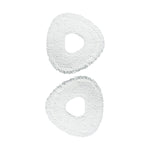Ever wondered what materials robot vacuums are made of? From the sturdy body to the internal components, every material has a role in ensuring durability and performance. This article answers that question by breaking down the key materials used in robot vacuums and why they matter for effective cleaning.
We’ll start by exploring the body materials like ABS plastic and polycarbonate, then dive into the cleaning mechanisms, including brushes and filters. Next, we’ll examine how metals are used in structural components, and the role of electronic materials like copper and fiberglass. We’ll also cover the sensors, batteries, wheels, and movement components that make robot vacuums so efficient. Finally, we’ll discuss finishing materials and the considerations for AU households, where diverse flooring and dusty environments require specific material choices to ensure top performance.
Whether you’re comparing models or just curious, this guide gives you a full picture of the materials powering your robot vacuum.
Body Materials
The outer body of a robot vacuum plays a crucial role in protecting its internal components while ensuring durability and performance. Key materials like ABS plastic, polycarbonate, and nylon are commonly used in robot vacuums due to their strength, flexibility, and resistance to wear and tear. Here’s a closer look at the materials that make up the body of these high-tech cleaning devices:
Plastics
ABS (Acrylonitrile Butadiene Styrene) is a popular plastic used in the construction of robot vacuum bodies due to its durability and impact resistance. This material is also favored for its aesthetic flexibility, allowing manufacturers to design sleek, modern-looking devices that can withstand the rigors of daily use.
Polycarbonate
Known for its high impact resistance and strength, polycarbonate is another material commonly used in robot vacuums. Its robustness ensures that the vacuum can endure knocks and drops, making it a reliable choice for critical components.
Nylon
Nylon offers a unique combination of strength and flexibility, making it suitable for high-stress components within the vacuum. Its ability to withstand wear and tear without losing its structural integrity is essential for the longevity of these devices.
Cleaning Mechanisms
Cleaning mechanisms are at the heart of every robot vacuum. These systems include brushes and filters, each made from materials chosen for durability, efficiency, and cleaning performance. Let’s explore how different materials support these core components:
Brushes
Robot vacuums use two main types of brushes: nylon bristle brushes and rubber brushes.
-
Nylon bristles are strong, flexible, and ideal for sweeping up dust and debris. They can reach into tight corners and along edges, making them great for deep cleaning.
-
Rubber brushes are especially effective for picking up pet hair and preventing tangles. Their smooth surface reduces hair wrapping, helping the vacuum stay efficient with less maintenance.
Filters
Filters trap dust, allergens, and particles during cleaning.
-
HEPA filters are often made from fiberglass or synthetic fibers. They capture fine dust and allergens, improving air quality — a key benefit for allergy-prone households.
-
Foam filters act as pre-filters, catching larger particles before they reach the main filter. This helps prolong the life of HEPA filters and maintain consistent performance.
Metal Components
Aluminum
Aluminum is often used for structural parts of robot vacuums due to its lightweight and corrosion-resistant properties. This metal helps in maintaining the device’s strength without adding unnecessary weight, enhancing maneuverability.
Stainless Steel
Stainless steel is the best choice for parts that need to be strong and resist corrosion. Its durability ensures that components like screws, shafts, and other critical parts remain functional over time, even with constant exposure to dust and debris.
Electronic Components
This part mostly consists of printed circuit boards (PCBs), which are further subdivided into two sections. They are:
Fiberglass
Fiberglass is commonly used as the substrate in PCBs due to its durability and non-conductive properties. It provides a stable platform for the electronic components, ensuring the vacuum’s reliability.
Copper
Copper is used for the electrical pathways on PCBs because of its excellent conductivity. This ensures efficient power distribution and signal transmission within the vacuum, which is crucial for its smooth operation.
Sensors

Without the sensors, we doubt if there would have been a robot vacuum to begin with. As such, sensors play an important role in the functionality of the robot vacuum cleaner. For this reason, we will discuss the components of the sensors your robot has.
First, we have infrared sensors. They are typically made of silicon and are used for obstacle detection. These sensors help the vacuum navigate around furniture and avoid collisions, enhancing its efficiency and preventing damage.
Secondly, we have the LIDAR components. They include laser diodes and receivers, which are made from semiconductor materials. These components provide precise mapping and navigation capabilities, allowing the vacuum to clean more effectively by understanding the layout of the space.
Batteries
Without the batteries, do you think your robot vacuum would function? No, it can’t. Therefore, you have to learn about this.
First, we have Lithium-ion batteries. We prefer them for their high energy density and long life. They provide the power needed for extended cleaning sessions and quick recharges, ensuring the vacuum is always ready to go. Notably, when you look at the batteries our Narwal Freo X Ultra or Freo X Plus has, you’ll notice they’re Lithium-ion batteries.
Secondly, there is the Nickel-Metal Hydride (NiMH). While less common, NiMH batteries are sometimes used due to their durability and cost-effectiveness. They offer a reliable power source for robot vacuums, though they generally have a shorter lifespan compared to lithium-ion batteries.
Wheels and Movement Components
Rubber is used for the wheels and treads to provide traction and durability. It ensures smooth movement across different floor types and helps the vacuum navigate obstacles.
Alternatively, plastic gears are also commonly used in the drive mechanism for their cost-effectiveness and durability. They are designed to withstand the stresses of regular use while keeping the vacuum’s manufacturing cost down.
However, for the wheels to stay in position, the metal bearings must come into play. This is because they are essential for ensuring smooth and reliable wheel movement. Furthermore, the bearings work to reduce friction and wear, contributing to the vacuum’s longevity and performance.
Finishing Materials
Assume the whole robot vacuum has been assembled, and what’s remaining is to apply some paint for the work to be done. For this to be completed, paint and coatings are applied to enhance the appearance and provide additional protection. These finishes help the vacuum look sleek and stylish while adding an extra layer of durability.
Besides the paints, adhesives are also an option. They are often made of synthetic resins and are used to bond various components. This ensures a secure fit and contributes to the overall structural integrity of the vacuum.

Australian Use Cases and Material Considerations
In Australia, robot vacuums are commonly used in homes with diverse flooring, ranging from hardwood in living areas to tiles in kitchens and bathrooms. Many Australian homes also feature floor-to-ceiling windows and open-plan living spaces, which can be challenging to clean due to their size and layout. Choosing a robot vacuum made from durable materials like ABS plastic and polycarbonate ensures it will perform well in these varied conditions, providing long-lasting reliability.
Additionally, as Australian homes often experience high levels of dust and pet hair, especially in rural or coastal areas, a robot vacuum with strong suction and efficient cleaning mechanisms—such as HEPA filters and rubber brushes—proves essential for effective cleaning and maintaining air quality.
Conclusion
Robot vacuums are made from different materials, each picked to improve durability, performance, and safety. From the sturdy plastics and metals that form the body to the advanced electronic components and cleaning mechanisms, every material plays a critical role in making these devices effective and reliable.
Next time you’re in the market for a robot vacuum, for instance, at Narwal, consider the materials used in its construction. Knowing what materials are used can help you choose a vacuum that is effective, durable, and safe for your home.









































